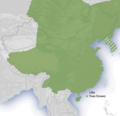This article possibly contains original research .(June 2023) |
This article needs additional citations for verification .(June 2023) |
| History of the Mongols |
|---|
 |
This is a list of Mongol states. The Mongols founded many states such as the vast Mongol Empire and other states. The list of states is chronological but follows the development of different dynasties.






































